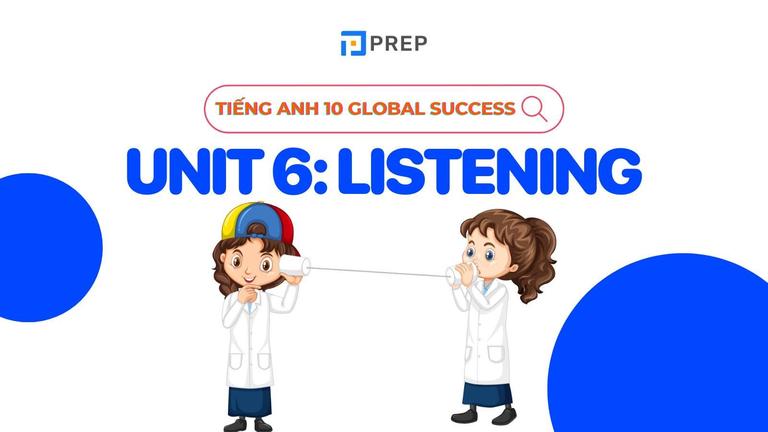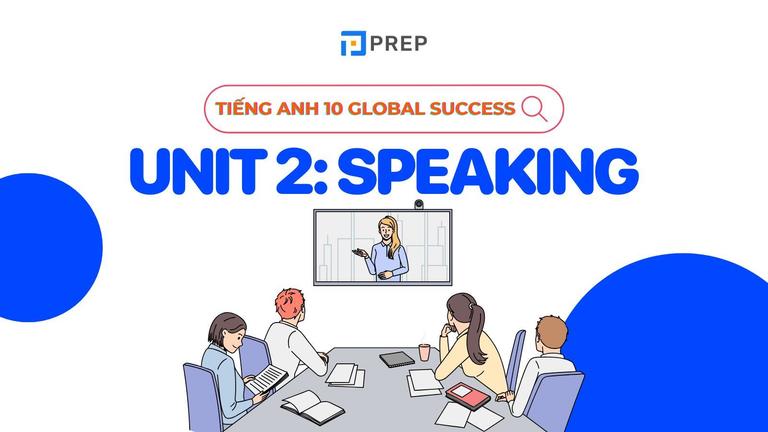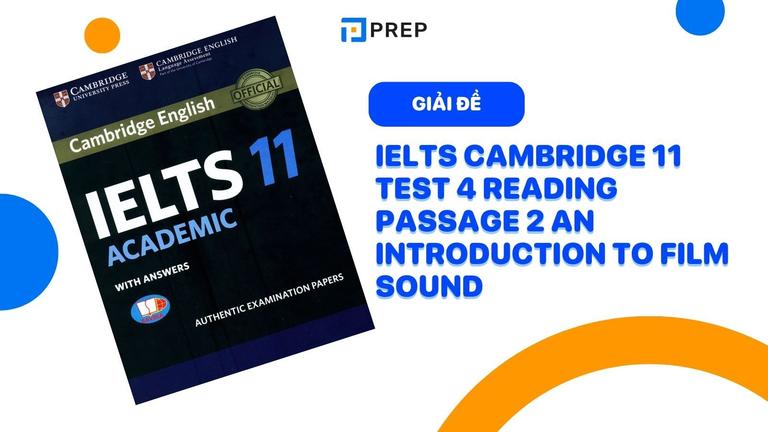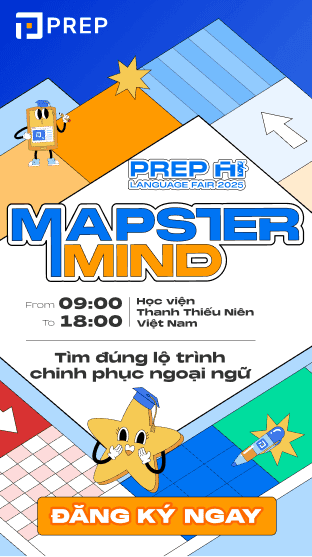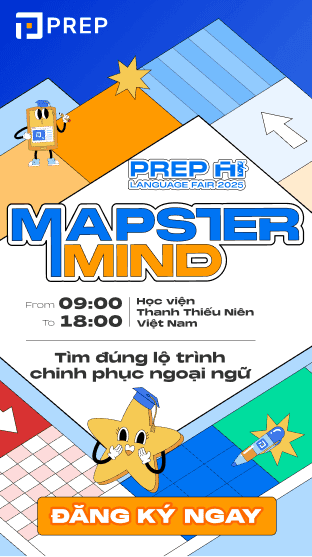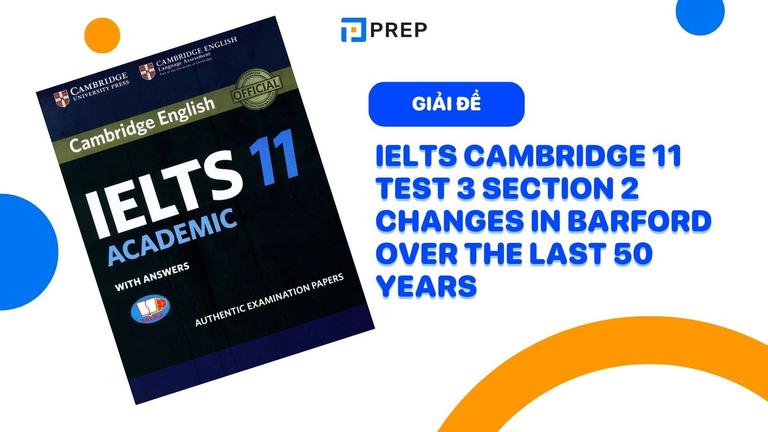Hướng dẫn học tiếng Anh 9 Unit 10: Planet Earth
Tiếng Anh 9 Unit 10 trong sách Global Success thuộc chủ đề Planet Earth. Cùng PREP tìm hiểu ngay dưới đây cấu trúc bài học, nội dung kiến thức và hoàn thành phần bài tập có đáp án đính kèm bạn nhé!
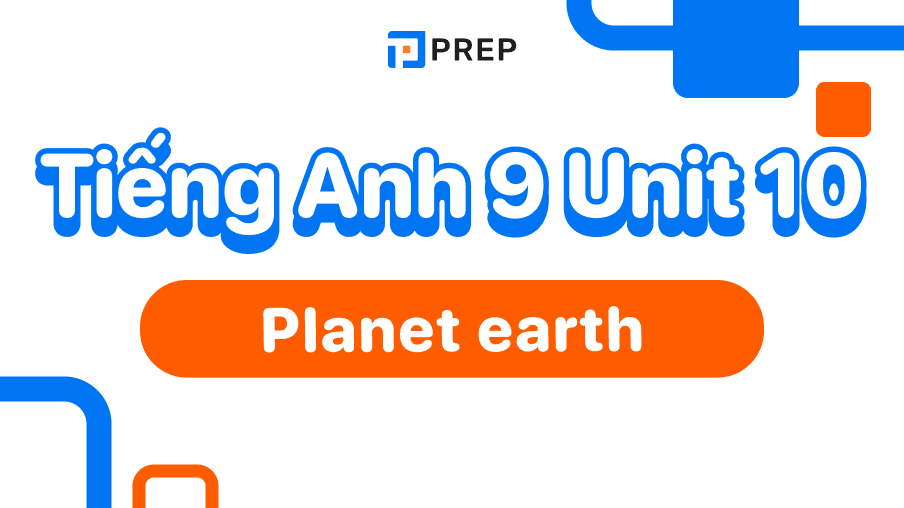
I. Giới thiệu về Unit 3 tiếng Anh 10
Trước khi học tiếng Anh 9 Unit 10, hãy cùng PREP điểm danh qua phần “Book Map” ngay dưới đây bạn nhé!
|
Kiến thức |
Nội dung |
|
Reading |
|
|
Speaking |
|
|
Listening |
|
|
Writing |
|
|
Language Focus |
|
Tham khảo thêm bài viết:
II. Từ vựng, ngữ pháp, phát âm trọng tâm trong Unit 10 tiếng Anh 9
Cùng PREP điểm qua kiến thức về từ vựng, ngữ pháp, phát âm trọng tâm trong Unit 10 tiếng Anh 9 dưới đây nhé!
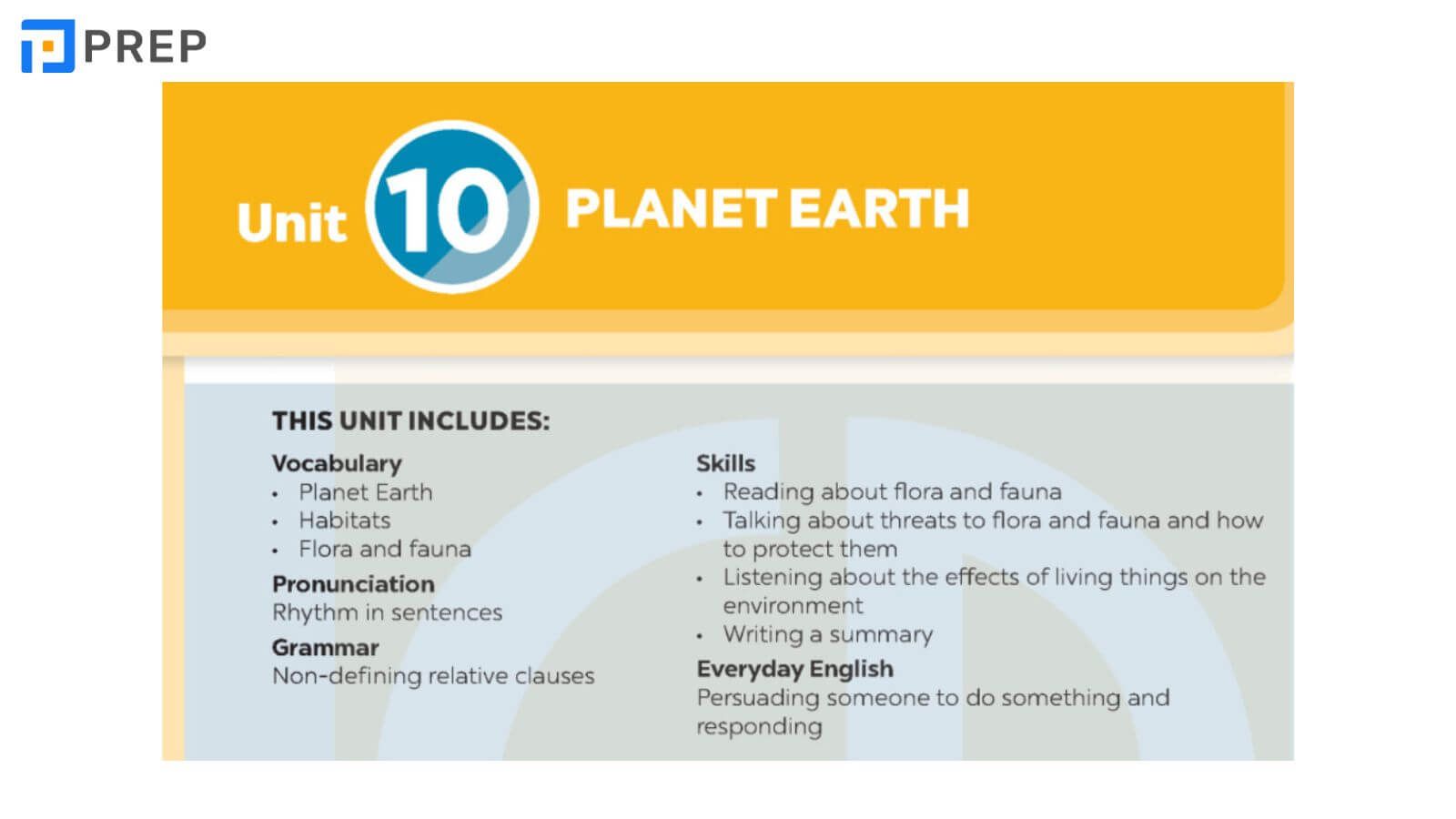
1. Từ vựng
|
Từ vựng |
Phiên âm |
Dịch nghĩa |
|
affect (v) |
/əˈfekt/ |
gây ảnh hưởng |
|
appreciate (v) |
/əˈpriːʃieɪt/ |
đánh giá cao |
|
climate change (n) |
/ˈklaɪmət tʃeɪndʒ/ |
biến đổi khí hậu |
|
droppings (n) |
/ˈdrɒpɪŋz/ |
phân (động vật) |
|
essential (adj) |
/ɪˈsenʃl/ |
vô cùng quan trọng |
|
ecological balance |
/ˌiːkəˈlɒdʒɪkl ˈbæləns/ |
cân bằng sinh thái |
|
fascinating (adj) |
/ˈfæsɪneɪtɪŋ/ |
rất thú vị và hấp dẫn |
|
fertilizer (n) |
/ˈfɜːtəlaɪzə/ |
phân bón |
|
food chain (n) |
/ˈfuːd tʃeɪn/ |
chuỗi thức ăn |
|
grassland (n) |
/ˈɡrɑːslænd/ |
khu vực đồng cỏ |
|
habitat (n) |
/ˈhæbɪtæt/ |
môi trường sống của động thực vật |
|
harm (v) |
/hɑːm/ |
làm hại |
|
landform (n) |
/ˈlændfɔːm/ |
dạng địa hình, địa mạo |
|
nature reserve (n) |
/ˈneɪtʃə rɪzɜːv/ |
khu bảo tồn thiên nhiên |
|
observe (v) |
/əbˈzɜːv/ |
quan sát, chú ý |
|
orbit (v) |
/ˈɔːbɪt/ |
quay quanh quỹ đạo |
|
outer space (n) |
/ˌaʊtə ˈspeɪs/ |
ngoài vũ trụ |
|
pesticide (n) |
/ˈpestɪsaɪd/ |
thuốc diệt cỏ |
|
pole (n) |
/pəʊl/ |
cực (bắc/ nam) |
|
preserve (v) |
/prɪˈzɜːv/ |
bảo tồn |
|
threat (n) |
/θret/ |
nỗi đe doạ |
|
vital (adj) |
/ˈvaɪtl/ |
quan trọng mức sống còn |
2. Ngữ pháp
Mệnh đề quan hệ không xác định (non-defining relative clause) là loại mệnh đề cung cấp thông tin bổ sung về người hoặc vật, nhưng không làm thay đổi ý nghĩa cơ bản của câu. Nếu bỏ đi mệnh đề quan hệ này, câu vẫn hoàn chỉnh về mặt ý nghĩa. Mệnh đề này luôn được ngăn cách bởi dấu phẩy. Ví dụ:
-
Mr. John, who is a doctor, is very kind. (Ông John, người là bác sĩ, rất tốt bụng.)
-
The Eiffel Tower, which is in Paris, is very famous. (Tháp Eiffel, mà nằm ở Paris, rất nổi tiếng.)
Để hiểu hơn về cách dùng của mệnh đề quan hệ không xác định, hãy cùng PREP tìm hiểu ngay bài viết viết “Kiến thức về mệnh đề quan hệ (Relative clauses) trong tiếng Anh” nhé!
3. Phát âm
Khi nói tiếng Anh, chúng ta cần đặt trọng âm đúng chữ cái, từ trong 1 câu. Việc đặt đúng trọng âm khiến câu nói của chúng ta thể hiện được đúng ý nghĩa mình muốn và khiến câu nói trôi chảy hơn.
III. Cấu trúc bài học Unit 10 tiếng Anh 9
Cùng PREP điểm qua cấu trúc bài học và nội dung kiến thức có trong Unit 10 tiếng Anh 9 bạn nhé!
1. Getting started
1.1. Listen and read
Nghe và đọc
President: Hi, welcome to our science club. Our topic today is planet Earth. Our guest is Mr An, an earth scientist.
Mr An: Hi everybody. Pleased to meet you. I'm looking forward to answering your questions about our planet.
Lan: Mr An, where's Earth in the Solar System?
Mr An: There are eight planets in the Solar System, and Earth is the third from the Sun, after Mercury and Venus. It's also the fifth largest in our system.
Nick: Is it also called the Blue Planet?
Mr An: Right From the outer space it looks blue because water covers more than 70 per cent of it.
Lan: Is it the only planet that has liquid water?
Mr An: Exactly Without it, there wouldn't be living things, like humans, or the flora and fauna of your habitat.
Nick: How about the role of air, light, and heat? How do they affect Earth?
Mr An: Well, water bodies and landforms which are main areas on Earth, together with air, light, and heat, provide essential habitats for plants and animals.
Nick: It's fascinating to observe and study these habitats.
Mr An: Yes. However, they are being destroyed by pollution. We should all help out to preserve them.
1.2. Read the conversation again and tick (✔) T (True) or F (False) for each sentence
Đọc lại đoạn hội thoại và đánh dấu (✔) T (Đúng) hoặc F (Sai) cho mỗi câu.)
|
T |
F |
|
|
1. The students are asking about the Solar System. |
||
|
2. Another name for Earth is the Blue Planet. |
||
|
3. Water covers four fifths of Earth. |
||
|
4. Water bodies and landforms are essential habitats for plants and animals. |
||
|
5. Mr An thinks pollution is threatening the habitats of plants and animals. |
1.3. Write a word or phrase from the box under the correct picture
Viết một từ hoặc cụm từ trong khung dưới bức tranh đúng.
|
liquid water; landforms; flora and fauna; water bodies; Solar System; outer space |
1.4. Complete each sentence with a word or phrase from
Hoàn thành mỗi câu bằng một từ hoặc cụm từ từ số 3.
1. _______ refer to the plants and animals of a particular place.
2. Oceans, seas, rivers, and lakes are different types of _______ on Earth.
3. There are eight planets in the _______.
4. The Soviet Union launched Sputnik 1 into _______ in 1957.
5. Some examples of _______ include mountains, grassland, and deserts.
1.5. Quiz
Làm việc theo nhóm. Trả lời các câu hỏi sau.
1. How many continents are there on Earth? (Trên Trái Đất có bao nhiêu châu lục?)
2. How many oceans are there on Earth? (Trên Trái Đất có bao nhiêu đại dương?)
3. How many moons orbit Earth? (Có bao nhiêu mặt trăng quay quanh Trái Đất?)
4. Which gas is essential for life on Earth? (Khí nào cần thiết cho sự sống trên Trái Đất?)
5. Which planet has conditions similar to those on Earth? (Hành tinh nào có điều kiện tương tự như Trái Đất?)
2. A Closer Look 1
2.1. Write a word or phrase from the box under each picture
Viết một từ hoặc cụm từ trong khung dưới mỗi bức tranh.
|
Habitats; flora and fauna; grassland; nature reserves; food chain; poles |

2.2. Complete each sentence with word or phrase from 2.1
Hoàn thành mỗi câu với từ hoặc cụm từ bài 2.1.
1. In a _______, some animals eat other animals and become food for a third group of animals.
2. A _______ is often wide and its plants are mostly grass and flowers.
3. Areas of land to protect animals and plants are called _______.
4. The North and South _______ are both extremely cold and icy.
5. Natural _______ for pandas are bamboo forests.
2.3. Choose the correct answer A, B, C, or D
Chọn câu trả lời đúng A, B, C hoặc D.
1. When humans use a natural habitat for farming and housing, they cause _______.
-
A. climate change
-
B. global warming
-
C. habitat loss
-
D. ecological balance
2. When Earth's average temperature increases, we face _______.
-
A. ecological balance
-
B. global warming
-
C. pollution
-
D. protection
3. Each of us can lend a hand to _______ the natural environment.
-
A. hunt
-
B. change
-
C. preserve
-
D. pollute
4. We can keep a(n) _______ by stopping hunting and cutting down trees.
-
A. ecological balance
-
B. habitat loss
-
C. climate change
-
D. nature reserve
5. One way to _______ Mother Earth is by planting more trees.
-
A. keep
-
B. harm
-
C. provide
-
D. protect
2.4. Listen to the sentences and pay attention to the bold syllables
Nghe các câu và chú ý đến các âm tiết in đậm. Người nói có nhấn trọng âm cho chúng không?
1. Earth is the third planet from the Sun. (Trái đất là hành tinh thứ ba tính từ Mặt trời.)
2. Oceans, seas, rivers, and lakes are water bodies. (Đại dương, biển, sông, hồ là các thủy vực.)
3. The North and South poles are extremely cold and icy. (Cực Bắc và Nam rất lạnh và băng giá.)
4. Do moonquakes last up to half an hour? (Trận động đất có kéo dài tới nửa giờ không?)
5. Preserving natural resources is very important. (Bảo tồn tài nguyên thiên nhiên là rất quan trọng.)
2.5. Circle the stressed syllables in the sentences
Khoanh tròn những âm tiết được nhấn mạnh trong câu. Nghe, kiểm tra và lặp lại.
1. We're doing a study on climate change.
2. What is the distance from Earth to Mars?
3. They'll have a discussion on natural habitats.
4. Plants provide us with food, oxygen, and energy.
5. Our school organised various activities on Earth Day.
3. A Closer Look 2
3.1. Complete the sentences with correct relative pronouns
Hoàn thành câu với đại từ quan hệ đúng.
1. Planet Earth, _______ is also called the Blue Planet, is covered with water and land.
2. Peter Molnar, _______ has done many studies on climate change, is one of the best-known Earth scientists.
3. Neil Armstrong, _______ trip to the moon marked a giant leap for mankind, was the first to walk on the moon.
4. Suoi Thau, _______ is in Ha Giang, is one of the most gorgeous grasslands in Viet Nam.
5. People often do green things to protect Earth on the Earth Day, _______ is celebrated on 22nd April.
3.2. Underline the relative clauses. Tick (✔) if the relative clause can be omitted
Gạch chân các mệnh đề quan hệ. Đánh dấu (✔) nếu mệnh đề quan hệ có thể được lược bỏ.
1. The second planet from the Sun is Venus, which is sometimes called the Earth's sister.
2. The ocean, which is the body of salt water, contains 97% of Earth's water.
3. Landforms make up the areas which include mountains, hills, plains, and plateaus.
4. One of the world's most famous Earth scientists is James Hutton, who is a British geologist.
5. Arctic Ocean ice and water make up a habitat for polar bears, whose main food is seals.
3.3. Complete each sentence (1-5) with a non-defining relative clause (A - E)
Hoàn thành mỗi câu (1-5) bằng mệnh đề quan hệ không xác định (A - E).
1. Mars, _______, is very much similar to Earth.
2. Earth, _______, is the fifth largest planet in our solar system.
3. The name of our planet, _______, simply means "the ground".
4. Cat Ba National Park, _______, is one of the most famous tropical rainforests in Viet Nam.
5. We were interested in the talk by Mr An, _______.
-
A. which is a Germanic word
-
B. which is also called the Red Planet
-
C. whose radius is nearly 4 million miles
-
D. who explained ecological balance to us
-
E. which has a large collection of animals, birds and reptiles, and unique plants
3.4. Combine the two sentences into one, using a non-defining relative clause
Kết hợp hai câu thành một, sử dụng mệnh đề quan hệ không xác định.
1. The Moon is Earth's only natural satellite. Its surface is dark.
2. Moonquakes are much weaker than Earthquakes. Moonquakes can last up to half an hour.
3. Mars has mountains and canyons on its surface. It is a rocky planet like Earth.
4. Venus is considered the twin sister of Earth. Venus has a similar size and structure as Earth.
5. We should protect rivers and lakes. Rivers and lakes provide humans with their main sources of fresh water.
3.5. Work in two groups
Làm việc theo hai nhóm. Lần lượt nói to một trong các vị trí trong bảng. Nhóm còn lại giải thích hoặc cung cấp thêm thông tin về điều đó. Đội nào có nhiều câu đúng nhất sẽ chiến thắng.
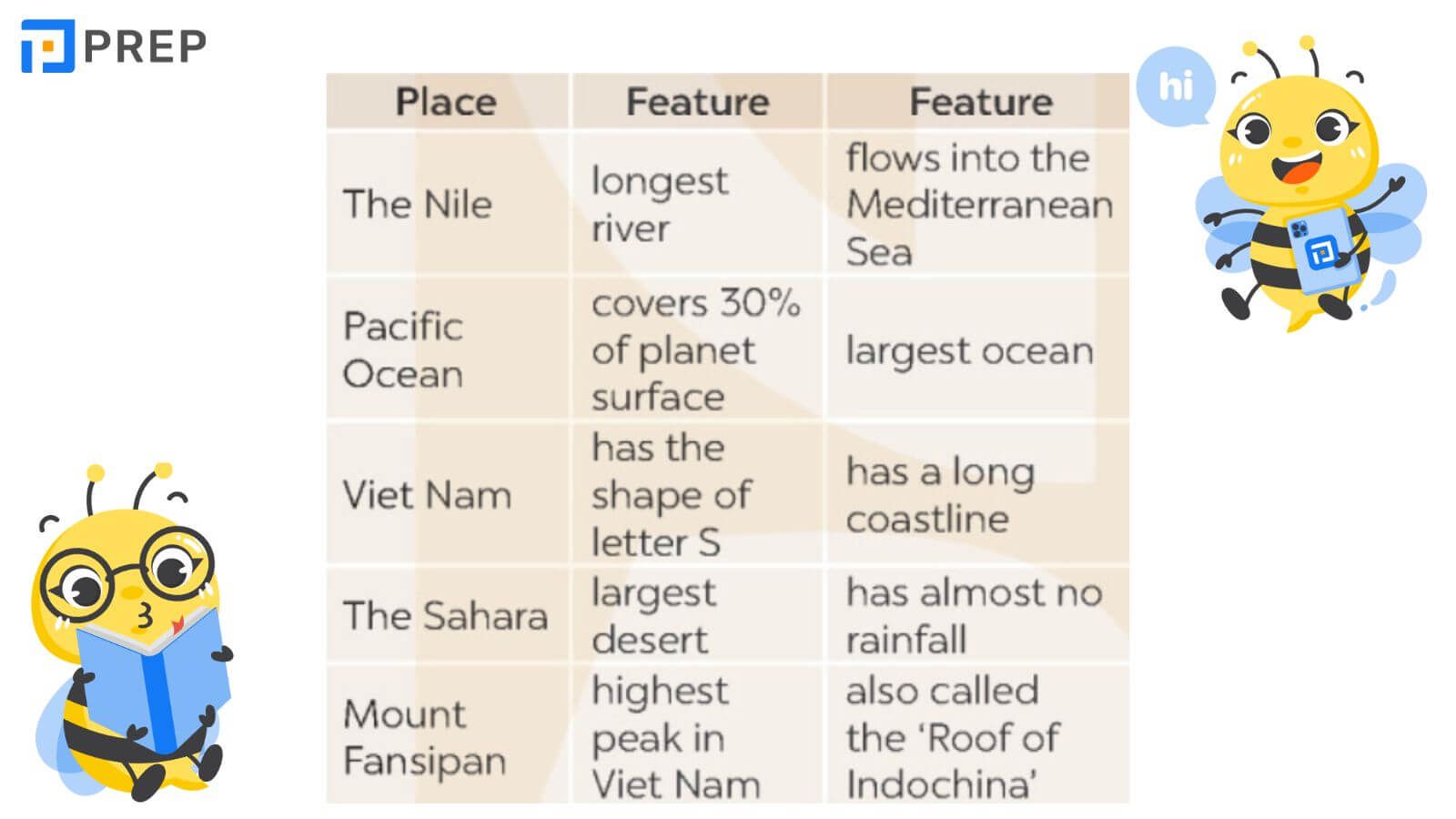
4. Communication
4.1. Listen and read the conversations
Nghe và đọc đoạn hội thoại. Hãy chú ý đến những phần được đánh dấu.
|
Bài nghe 1 |
Bài nghe 2 |
|
|
4.2. Work in pairs
Làm việc theo cặp. Thực hiện các cuộc hội thoại tương tự với các tình huống sau.
1. You persuade your friend to watch a movie about planet Earth.
2. You persuade local people to contribute to a fund to build a nature reserve.
4.3. Read the short descriptions of various habitats and match them with their features
Đọc những mô tả ngắn gọn về các môi trường sống khác nhau và nối chúng với các đặc điểm của chúng.
Polar habitats include the North Pole and the South Pole. These habitats are covered in ice and extremely cold and dry. Animals here include small fish, polar bears, penguins, leopard seals, etc.
Forest habitats include tropical forests, temperate forests, and boreal forests. They are considered the Earth's lungs because they produce oxygen. They also provide homes to bats, owls, deer, squirrels, foxes, lizards, etc.
Ocean habitats include the Pacific, Atlantic, Indian, Southern, and Arctic Oceans. They produce more than 50 per cent of Earth's oxygen and help adjust the climate. They provide living places for plants like sea grasses, microscopic algae, and fish, etc.
Grasslands include tropical and temperate ones. The main plants are grasses. They are crucial for grazing livestock. Grassland animals include giraffes, zebras, lions, elephants, etc.
|
1. Polar regions |
a. two main types and are crucial for livestock grazing |
|
2. Forests |
b. largest, produce oxygen and adjust the climate |
|
3. Oceans |
c. extremely cold, dry, covered in snow and ice |
|
4. Grasslands |
d. the lungs of Earth, home to many species |
4.4. Work in pairs
Làm việc theo cặp. Chọn hai môi trường sống và so sánh chúng.
You can refer to the following (Bạn có thể tham khảo như sau):
-
their specific types/examples (loại/ví dụ cụ thể của chúng)
-
their importance (tầm quan trọng của chúng)
-
plants/animals living there (thực vật/động vật sống ở đó)
-
other special features (các đặc điểm đặc biệt khác)
4.5. Report the results of your comparison to the class
(Báo cáo kết quả so sánh của bạn với cả lớp.)
5. Skills 1
5.1. Tick (✓) the things that show the roles of plants and animals
Đánh dấu (✓) những điều thể hiện vai trò của thực vật và động vật.
1. providing sources of food
2. causing habitat loss
3. keeping the ecological balance
4. making Earth beautiful
5.2. Read the passage and choose the correct answer A, B, C, or D
Đọc đoạn văn và chọn câu trả lời đúng A, B, C hoặc D.
Plants and animals are an essential part of Earth's ecology. When we speak about a specific habitat and time, we refer to them as flora and fauna. Flora refers to plants and fauna refers to animals. They are fascinating to study due to their beauty and significance to human life.
First, the flora and fauna on Earth create an ecological balance, making life possible for humans. Flora releases oxygen for humans. The carbon dioxide we breathe out is vital to plants. Humans also rely on the plants and animals for food, medicine, and water.
Second, plants and animals combine to create a food chain. In the food chain, the animals play an important part. They feed on plants and, in turn, are the prey of other animals. Their droppings become fertilizers for plants.
Finally, plants and animals add a lot of beauty to our earth. People love and appreciate the natural beauty, the relaxed feeling in green spaces and water areas.
However, plants and animals are facing habitat loss, pollution, and climate change. To protect them, we should raise people's awareness of their significance, stop hunting, plant more trees, and build nature reserves for our wildlife.
1. What is the passage mainly about?
-
A. The beauty of plants and animals.
-
B. How plants and animals protect the environment.
-
C. The wonder of plants and animals.
-
D. The natural food chain.
2. The author mentions _______ significant roles plants and animals play.
-
A. two
-
B. three
-
C. four
-
D. five
3. Which of the following do plants provide humans?
-
A. Oxygen.
-
B. Aquatic environment.
-
C. Carbon dioxide
-
D. Habitat loss.
4. Which action does NOT preserve plants and animals?
-
A. Planting more trees.
-
B. Raising awareness.
-
C. Building nature reserves.
-
D. Hunting animals.
5. The word "appreciate" means _______.
-
A. protect the qualities of
-
B. recognise the wonder of
-
C. learn more about
-
D. be aware of
5.3. Read the passage again and fill in the diagram
Đọc lại đoạn văn và điền vào sơ đồ.
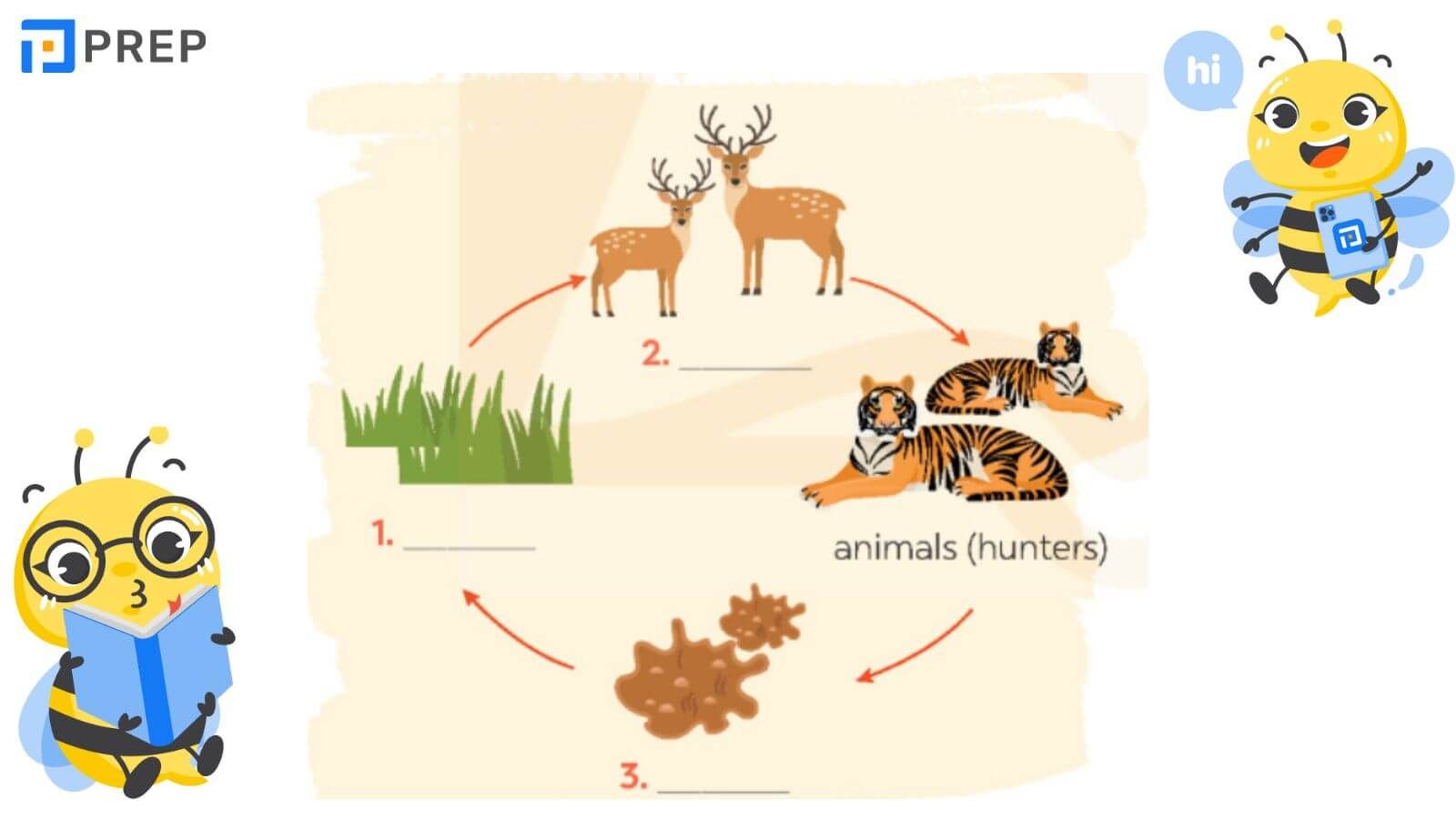
5.4. Work in pairs
Làm việc theo cặp. Thảo luận về các mối đe dọa đối với thực vật và động vật và cách chúng ta có thể bảo vệ chúng. Bạn có thể sử dụng những ý tưởng từ bài đọc hoặc ý tưởng của riêng bạn.
|
Threats |
Actions |
|
… |
… |
5.5. Report the results of your discussion to the class
Báo cáo kết quả thảo luận của bạn trước lớp.
6. Skills 2
6.1. Look at the pictures and answer the questions below
(Quan sát các bức tranh và trả lời các câu hỏi dưới đây.)
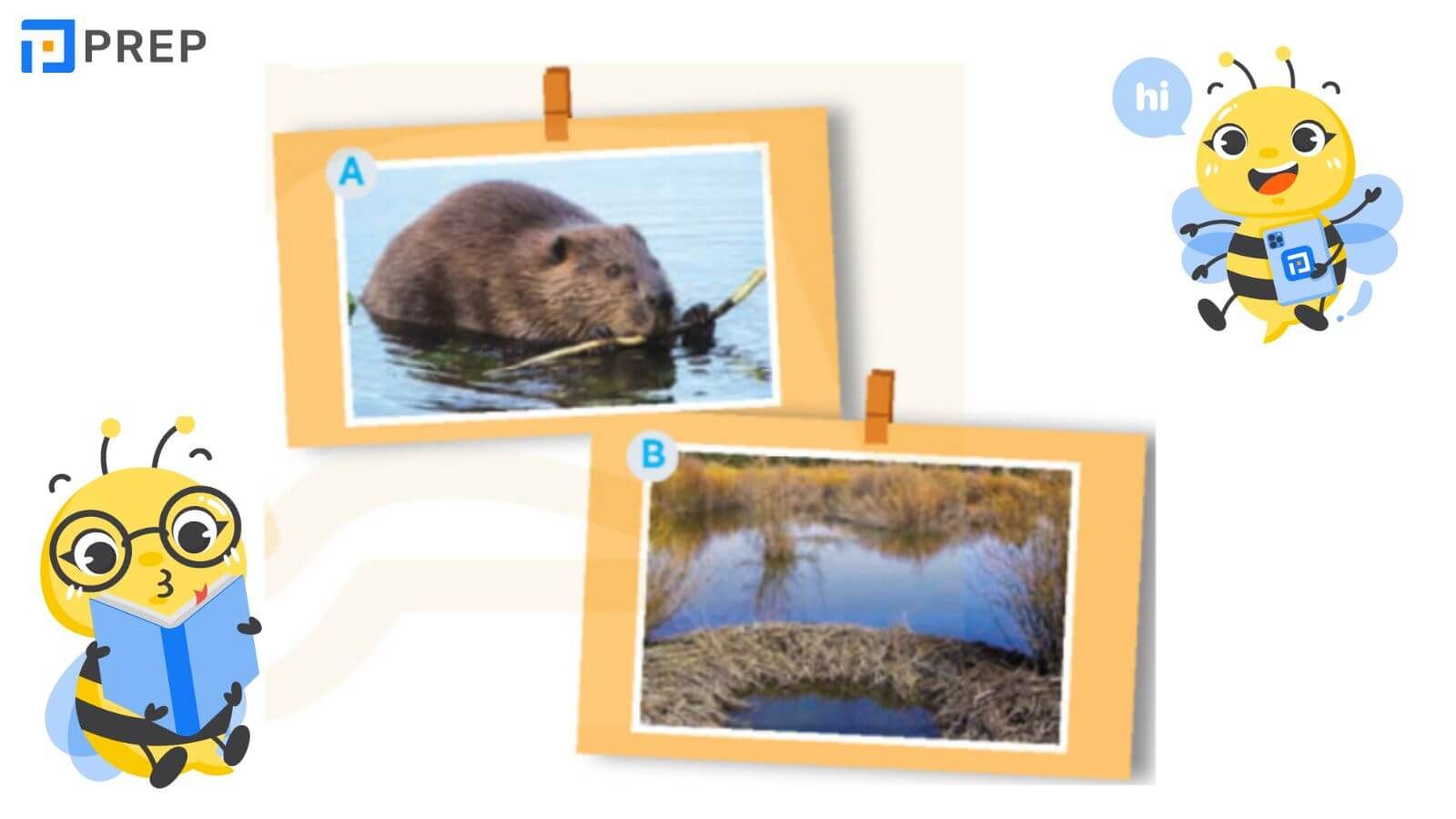
1. Which animal do you see in picture A?
2. What is it doing in picture A?
3. What do you see in picture B?
6.2. Listen to a conversation and choose the correct answer A, B, or C
Nghe đoạn hội thoại và chọn câu trả lời đúng A, B hoặc C.
1. Mr An is talking about _______.
-
A. effects of the habitats on plants and animals
-
B. the effects of habitat loss
-
C. effects of plants and animals on the habitats
2. What did Mr An suggest humans should do?
-
A. Bring plants and animals from one place to another.
-
B. Preserve habitats.
-
C. Use pesticides.
6.3. Listen again and fill in each blank in the summary with ONE word
(Nghe lại và điền vào mỗi chỗ trống trong phần tóm tắt MỘT từ.)
|
Effects from plants |
- They help or (1) _______ the environment. - They make a place more beautiful. - They (2) _______ over the resources of local plants. |
|
Effects from animals |
- They can cause harm to or (3) _______ a habitat. - Beavers can build dams and ponds, which helps some plants and animals. - Beavers may (4) _______ the homes of other plants and animals. |
|
We should |
- (5) _______ habitats. - stop destroying forest habitats. - stop using (6) _______. |
6.4. Work in pairsLàm việc theo cặp. Hỏi và trả lời các câu hỏi dưới đây.
1. What is the main topic of Mr An's talk?
2. How do plants affect their habitat?
3. How do animals affect their habitat?
4. What should humans do?
6.5. Write a summary (100-120 words)
Viết tóm tắt (100-120 từ) những điểm chính của cuộc trò chuyện. Sử dụng thông tin ở phần 3 và câu trả lời ở phần 4.
7. Looking Back
7.1. Fill in the table with words and phrases about habitats
(Điền vào bảng những từ và cụm từ về môi trường sống.)
|
Types of habitats |
Things in a habitat |
|
… |
… |
7.2. Complete the passage, using the words and phrases in the box
Hoàn thành đoạn văn bằng cách sử dụng các từ và cụm từ trong hộp.
|
nature reserves; habitat loss; ecological balance; food chain; climate change |
Earth's habitats are various and many are threatened. Each habitat includes living things, non-living things, and the surrounding environment. The relations of all living things and their environment in a habitat make up the habitat's ecology. (1) _______ or changes in population of plants and animals can cause changes to the natural (2) _______ and the ecology. That means to maintain a(n) (3) _______, we shouldn't cause changes to the climate and the plants and animals of any habitat. In many countries, people have built (4) _______ to keep endangered plants and animals safe. People should also avoid activities that may cause pollution and (5) _______
7.3. Complete each sentence (1-5) with a non-defining relative clause (A-E)
Hoàn thành mỗi câu (1-5) bằng mệnh đề quan hệ không xác định (A-E).
1. The Alps are a well-known mountain range, _______.
2. Deserts on Earth, _______, hardly get any rain.
3. People used to believe that Thor, _______, causes storms and lightning.
4. We spent time trekking, bird-watching, and kayaking in Cuc Phuong, _______.
5. James Hutton, _______, was one of the first scientists to study geology.
-
A. who is considered the God of Thunder
-
B. which are large and extremely dry areas
-
C. whose work in geology is considered very important
-
D. which is the oldest national park in Viet Nam
-
E. which attract many tourists worldwide
7.4. Combine the two sentences into one, using a non-defining relative clause
Kết hợp hai câu thành một, sử dụng mệnh đề quan hệ không xác định.
1. Boreal forests cover vast areas in Canada, Alaska, and Russia. They are also called Ta2. Polar bears are endangered animals. Their natural habitat is the Arctic.
3. Julie Arblaster focuses on studying climate change. She is an Australian scientist.
4. Antarctica is Earth's least populated continent. It is surrounded by the Southern Ocean.
5. The natural world is the world of living things. Living things include plants and animals.
8. Project
8.1. Work in groups
Làm việc nhóm.
Choose an area you know/like. (Chọn một khu vực bạn biết/thích.)
8.2. Collect pictures of some flora and/or fauna in that area
Thu thập tranh ảnh về một số loài thực vật và/hoặc động vật ở khu vực đó.
8.3. Create a poster
Tạo một tấm áp phích.
8.4. Introduce the area's flora and fauna to the class
Giới thiệu hệ thực vật và động vật của khu vực với lớp.
IV. Đáp án bài tập tiếng Anh 9 Unit 10
Dưới đây PREP đã sưu tầm đáp án và lời giải gợi ý cho các bài tập trong tiếng Anh Unit 10, tham khảo ngay bạn nhé!
Trên đây PREP đã chia sẻ đầy đủ từ vựng, ngữ pháp, cấu trúc, kiến thức bài học và đáp án đi kèm trong tiếng Anh 9 Unit 10. Thường xuyên truy cập vào PREP để tham khảo thêm nhiều kiến thức tiếng Anh bổ ích bạn nhé!

Chào bạn! Mình là Hiền Hoàng, hiện đang đảm nhận vai trò quản trị nội dung sản phẩm tại Blog của website prepedu.com.
Với hơn 5 năm tự học các ngoại ngữ như tiếng Anh, tiếng Trung và ôn luyện một số kỳ thi IELTS, TOEIC, HSK, mình đã tự đúc rút được nhiều kinh nghiệm để hỗ trợ hàng nghìn người đang gặp khó khăn trong việc học ngoại ngữ. Hy vọng rằng những chia sẻ phía trên sẽ giúp ích cho bạn trong quá trình tự ôn luyện thi hiệu quả tại nhà!
Bình luận
Nội dung premium
Xem tất cảLộ trình cá nhân hoá
Có thể bạn quan tâm
Kết nối với Prep

MSDN: 0109817671.
Địa chỉ liên hệ: Tòa nhà Vinaconex, 34 Láng Hạ, phường Láng, TP Hà Nội.
Trung tâm CSKH tại HN: Lô 21 C2 Khu đô thị Nam Trung Yên, phường Yên Hòa, TP Hà Nội.
Trung tâm CSKH tại HCM: 288 Pasteur, Phường Xuân Hòa, TP Hồ Chí Minh
Trụ sở Công ty: Số nhà 20, ngách 234/35 đường Hoàng Quốc Việt, phường Nghĩa Đô, TP Hà Nội.
Phòng luyện ảo - Trải nghiệm thực tế - Công nghệ hàng đầu.
Hotline: 0931 42 8899.
Trụ sở Công ty: Số nhà 20, ngách 234/35 đường Hoàng Quốc Việt, phường Nghĩa Đô, TP Hà Nội.
Giấy chứng nhận hoạt động đào tạo, bồi dưỡng số 1309/QĐ-SGDĐT ngày 31 tháng 07 năm 2023 do Sở Giáo dục và Đào tạo Hà Nội cấp.
